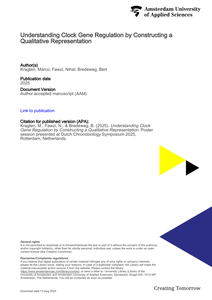We developed an application which allows learners to construct qualitative representations of dynamic systems to aid them in learning subject content knowledge and system thinking skills simultaneously. Within this application, we implemented a lightweight support function which automatically generates help from a norm-representation to aid learners as they construct these qualitative representations. This support can be expected to improve learning. Using this function it is not necessary to define in advance possible errors that learners may make and the subsequent feedback. Also, no data from (previous) learners is required. Such a lightweight support function is ideal for situations where lessons are designed for a wide variety of topics for small groups of learners. Here, we report on the use and impact of this support function in two lessons: Star Formation and Neolithic Age. A total of 63 ninth-grade learners from secondary school participated. The study used a pretest/intervention/post-test design with two conditions (no support vs. support) for both lessons. Learners with access to the support create better representations, learn more subject content knowledge, and improve their system thinking skills. Learners use the support throughout the lessons, more often than they would use support from the teacher. We also found no evidence for misuse, i.e., 'gaming the system', of the support function.
DOCUMENT

Systems thinking is a complex skill for learners in secondary education. We argue that qualitative representations can be valuable tools to actively engage in learning this skill. However, the effectiveness of these tools is currently hampered by complexity and the lack of instructional embedding. In this contribution, we present our developments on scaffolds for learning, instructional formats, and automated support in order to unleash the potential of qualitative representations for secondary education.
DOCUMENT

We investigate how interactive representations can be used to support learners while learning about the circular motion of celestial bodies. We present the developed representation and accompanying lesson, and report on the effect.
DOCUMENT
Circular and elliptical motion are fundamental topics in physics education, yet learners often struggle to grasp them. We investigate how interactive qualitative representations can be used to describe the characteristic behavior of circular and elliptical motion. We use the vocabulary and algorithms known as qualitative reasoning, which make it possible to represent the distinct features of these systems in a conceptual way. Leveraging the close alignment between qualitative reasoning and human reasoning about dynamic systems, these representations have the potential to enhance understanding in this domain.
DOCUMENT

This contribution presents three lesson activities for lower secondary education that were developed to teach system thinking in concert with subject matter. The pedagogical approach is described, leading to a practical design philosophy for lesson activities using qualitative representations. These representations allow for capturing basic qualitative notions, such as the entities that constitute the system, their changeable features referred to as quantities, and cause-effect relations that propagate changes between these quantities.
DOCUMENT

Learning by creating qualitative representations is a valuable approach to learning. However, modelling is challenging for students, especially in secondary education. Support is needed to make this approach effective. To address this issue, we explore automated support provided to students while they create their qualitative representation. This support is generated form a reference model that functions as a norm. However, the construction of a reference models is still a challenge. In this paper, we present the reference model that we have created to support students in learning about the melatonin regulation in the context of the biological clock.
DOCUMENT

In this paper, we discuss the pedagogical approach of two lessons that are aimed at learning domain knowledge and systems thinking simultaneously using qualitative representations. Next to understanding basic cause-effect relationships, these lessons focus on the notion that systems can move through different states of behavior. An additional focus concerns system boundaries and distinguishing between what is part-of and not part-of a system.
DOCUMENT

This paper presents three lesson activities for upper secondary education that focus on learning subject specific knowledge and general system thinking skills by creating a qualitative representation. The learning goals and the pedagogical approach are described.
DOCUMENT

In this paper, we focus on how the qualitative vocabulary of Dynalearn, which is used for describing dynamic systems, corresponds to the mathematical equations used in quantitative modeling. Then, we demonstrate the translation of a qualitative model into a quantitative model, using the example of an object falling with air resistance.
DOCUMENT

We developed a lesson where students construct a qualitative representation to learn how clock genes are regulated. Qualitative representations provide a non-numerical description of system behavior, focusing on causal relation-ships and system states. They align with human reasoning about system dy-namics and serve as valuable learning tools for understanding both domain-specific systems and developing broader systems thinking skills.The lesson, designed for upper secondary and higher education, is imple-mented in the DynaLearn software at Level 4, where students can model feedback loops. Students construct the representation step by step, guided by a structured workbook and built-in support functions within the software. At each step, they run simulations to examine system behavior and reflect on the results through workbook questions. To ensure scientific accuracy, the representation and workbook were evaluated by domain experts.The lesson begins with modeling how increasing BMAL:CLOCK activity enhances the transcription of PER and CRY genes through binding to the E-box. Next, students explore how mRNA production and degradation—two opposing processes—regulate mRNA levels. This is followed by modeling translation at the ribosomes, where PER and CRY proteins are synthesized and subsequently degraded, again illustrating competing regulatory process-es. Students then model how PER and CRY proteins form a complex that translocates to the nucleus, inhibiting CLOCK:BMAL binding and establish-ing a negative feedback loop. Finally, they extend their understanding by ex-ploring how CLOCK:BMAL also regulates the AVP gene, linking clock genes to broader physiological processes.
MULTIFILE
